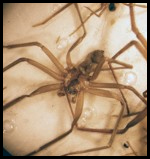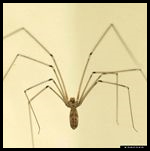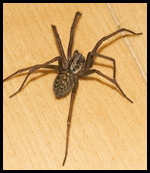Black Widow Spiders

Black Widow Spiders
Lactrodectus mactans
| Color: |
Black, with characteristic red "hourglass" on back |
| Legs: |
8 |
| Shape: |
Round |
| Size: |
3/4" length; 3/8" in diameter |
| Antennae: |
False |
| Region: |
Found throughout U.S. |
Black widow spiders are most recognized for the red hourglass shape under their abdomen. Contrary to legend, female black widow spiders rarely devour the male black widow spider after mating.
Habits
Black widow spiders spin their webs near ground level. They often build their webs in protected areas, such as in boxes and in firewood.
Habitat
Black widow spiders are often found around wood piles and gain entry into a structure when firewood is carried into a building. They are also found under eaves, in boxes, and other areas where they are undisturbed.
Threats
The venom of a black widow spider is a neurotoxin and is used as a defense. Black widow spiders do not bite humans instinctively. The black widow spider bite can cause severe pain. Young children and the elderly are especially susceptible to a severe reaction to a black widow spider bite.
Prevention:
Avoid black widow spider bites by wearing heavy gloves when moving items that have been stored for a long period of time. Spiders often hide in shoes, so check shoes and shake them out before wearing. When spider webs are visible, use caution before putting your hands or feet in that area.
SetFontSize();
Brown Recluse Spiders

Brown Recluse Spiders
Loxosceles reclusa
| Color: |
Light to dark brown, with characteristic dark brown violin marking on back |
| Legs: |
8 |
| Shape: |
Round |
| Size: |
5/8" |
| Antennae: |
False |
| Region: |
Found in the south central Midwest from Ohio to Nebraska and southward through Texas to Georgia |
Brown recluse spiders have a characteristic dark brown violin marking on their back.
Habits
Brown recluse spiders are nocturnal and eat other bugs like cockroaches and crickets. Male brown recluse spiders wander farther than females and will crawl into shoes or other clothing.
Habitat
Brown recluse spiders often live outdoors in debris and wood piles. They can be found indoors in storage areas and dark recesses.
Threats
Like the black widow spider, the brown recluse spider bites in defense and does not bite humans instinctively. They will bite humans when the clothing they are hiding in is worn. The brown recluse spider bite is painful and can produce an open, ulcerating sore.
Prevention:
To avoid brown recluse spiders, avoid keeping clothing on the floor. Store clothing and shoes inside plastic containers, and shake out all clothing that has been in a hamper before wearing or washing.
SetFontSize();
Long-bodied Cellar Spiders

Long-bodied Cellar Spiders
Pholcus phalangioides
| Color: |
Pale yellow to light brown or gray |
| Legs: |
8 |
| Shape: |
Long skinny legs with a small body |
| Size: |
¼-3/8" (6-9mm) |
| Antennae: |
False |
| Region: |
Found throughout U.S. |
Cellar spiders are commonly referred to as "daddy-long-legs" because of their very long, thin legs and as their name implies are found in dark and damp places. There are about 20 species of cellar spiders in the United States and Canada.
Habits
Cellar spiders build loose, irregular, tangled webs in corners. They hang upside down on the underside of the web. The webs are not cleaned but instead a new web is continually added. This habit can result in extensive webbing in a relatively short time.
Habitat
The spiders and their webs are usually found in dark and damp places, such as cellars, basements, and crawl spaces. They can also be found in the corners of garages, sheds, barns, and warehouses, on eaves, windows, and ceilings, and in closets, sink cabinets, and bath-traps. Cellar spiders seem to fare better in areas with higher relative humidity,
Threats
Cellar spiders do not pose a threat to humans. While they are commonly found in homes, they usually stay in one place. They are not known to bite. Urban legend has it that their venom is of the most deadly of spiders, but their weak mouthparts keep them from injecting venom into humans. While it is correct that they cannot successfully bite, their venom is not very potent.
Prevention:
Seal cracks on the outside of the home, especially around doors and windows, and use screens to prevent entry into homes. Using yellow light bulbs for exterior lighting may reduce the number of spiders and other insects as they are typically attracted to white-light sources. Additionally, lowering the humidity in basements, cellars and crawl spaces with the use of a dehumidifier or ventilation can discourage cellar spiders from living there.
SetFontSize();
House Spiders (Common/Domestic Spiders)

House Spiders (Common/Domestic Spiders)
Achaearanea tepidariorum
| Color: |
Yellowish brown, abdomen dirty white with a few dark spots (sometimes with a black triangular spot in the center) to almost black, with several dark stripes meeting at angle above tip of abdomen; legs |
| Legs: |
8 |
| Shape: |
Elongated abdomen |
| Size: |
3/16 – 5/16" (female) 1/8 – 3/16" (male) |
| Antennae: |
False |
| Region: |
Found throughout U.S. |
This is usually the spider most often encountered indoors. It is a nuisance pest, probably more because of its webs than the spider itself. This spider is found worldwide and is common throughout the United States and Canada.
Habits
The house spider randomly selects its web sites and creates a tangled web. If a web does not yield prey it is abandoned, another site is selected, and a new web is built. Survival is low in modern homes with low humidity and few insects, higher in garages, sheds, barns, warehouses, etc. because of more prey and generally higher humidity, and highest outdoors in protected places.
Habitat
Inside structures, house spiders are most likely to be found in upper corners, under furniture, in closets, angles of window frames, basements, garages, and crawl spaces. Outside they are often around windows and under eaves especially near light sources which attract prey.
Threats
House spiders are nuisance pests but pose no threats to humans.
Prevention:
Seal cracks and use screens on windows and doors. Use a vacuum to remove adults, egg sacs and webs. If a broom is used, adults usually escape.
SetFontSize();
Jumping Spiders
Jumping Spiders
Salticidae
| Color: |
Usually black, sometimes brown, tan, or gray, and usually with pale markings of white, gray, yellow, red, blue and/or green. They are typically covered with hairs or scales, often brightly colored or |
| Legs: |
8 |
| Shape: |
Compact with relatively short legs |
| Size: |
1/8 – 3/4" |
| Antennae: |
False |
| Region: |
Found throughout U.S. |
The common name comes from their jumping ability and habit which they use to capture prey. They are an occasional nuisance pest indoors, and some colored species may cause concern when people mistake them for Black Widow spiders. About 300 species of jumping spiders are found in the United States and Canada.
Habits
Jumping spiders do not construct snare webs but do build web retreats which are loosely woven, saclike, composed of several envelopes and usually have two openings. Unlike most spiders, jumping spiders are active during the daytime and seem to like sunshine. They are hunters and have the keenest vision of all spiders, being able to detect and react to movement up to 18" in distance; however their night vision is very poor. They can rapidly move both sideways and backwards for short distances. As their name implies, they are excellent jumpers.
Habitat
Retreats may be built under furniture, in drapery folds, between books on bookshelves, in cracks found in wood floors, around door and window molding, etc. Outside retreats may be found under loose bark, between leaves, etc. Indoors, spiders will usually be found hunting around windows and doors because more insects are attracted to these areas and their vision is best in sunlit areas. Outdoors, jumping spiders are commonly seen running over tree bark, under stones and boards, on bushes, fences, decks and the outside of buildings, especially sunny areas.
Threats
Jumping spiders can bite, but they are not considered dangerous.
Prevention:
In addition to sealing cracks and screening doors and windows, exclusion and the removal of outdoor harborages is key. Indoors, removal with a vacuum is best followed by disposal of the vacuum bag outside.
|

|
|

